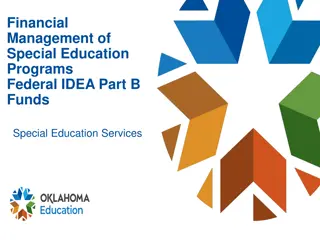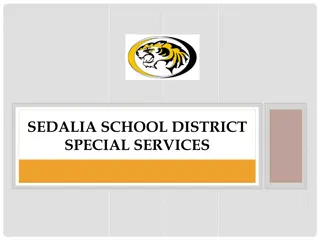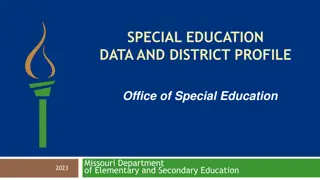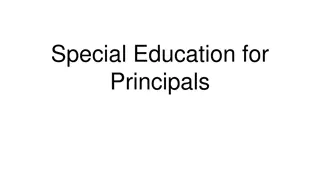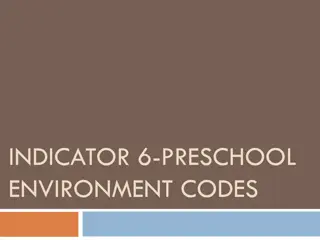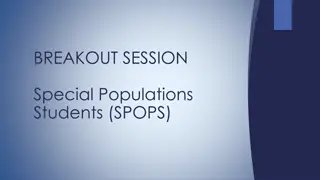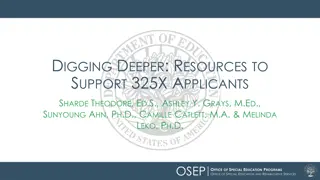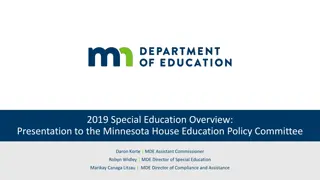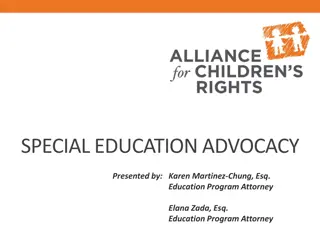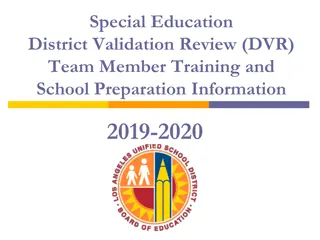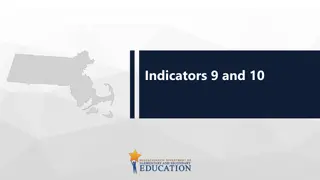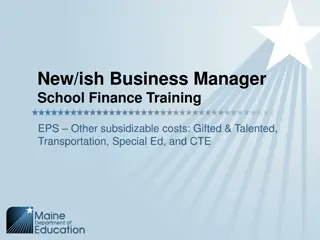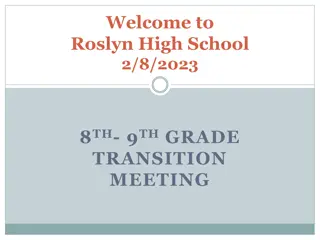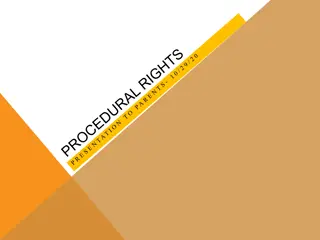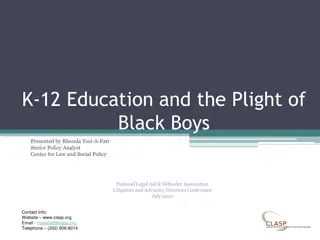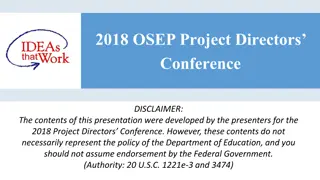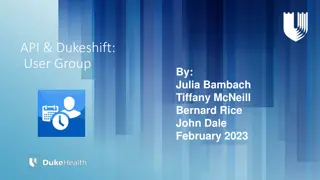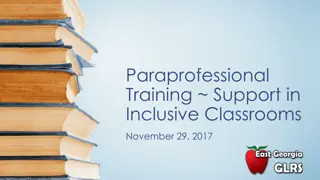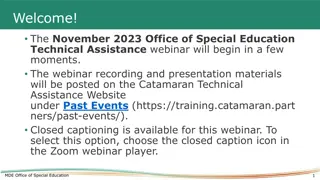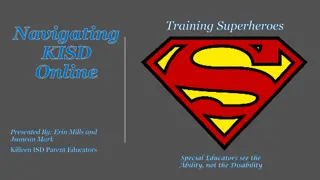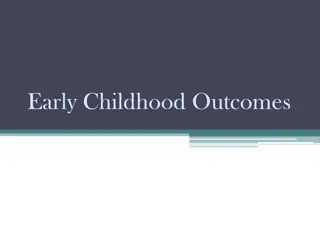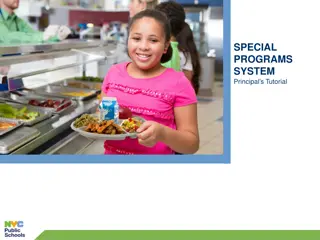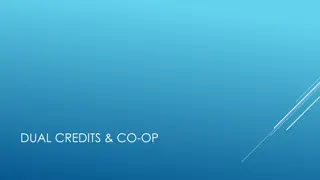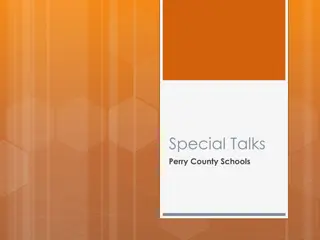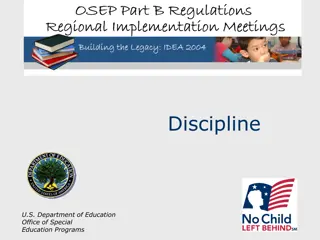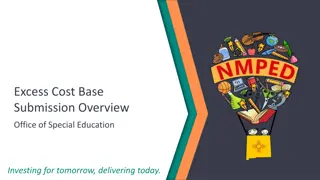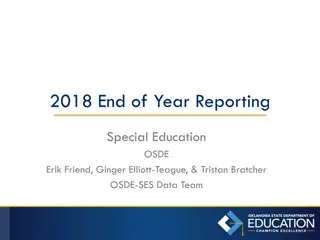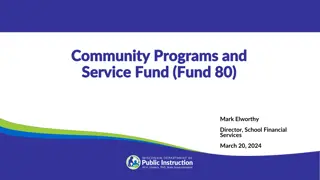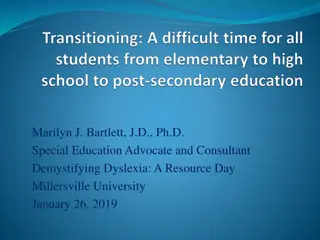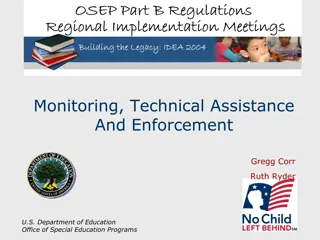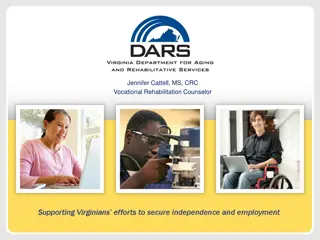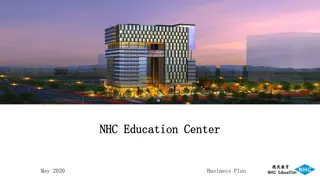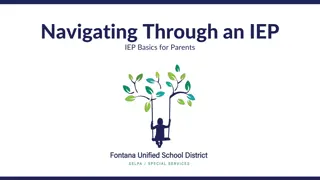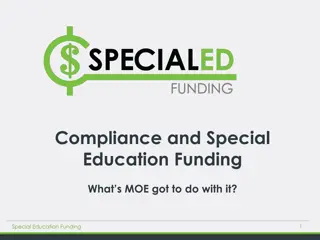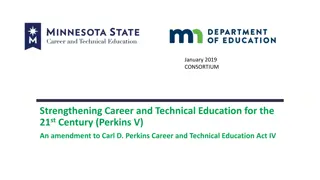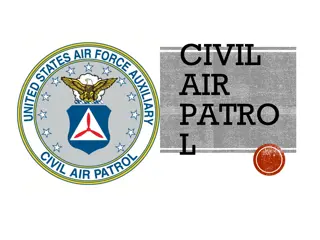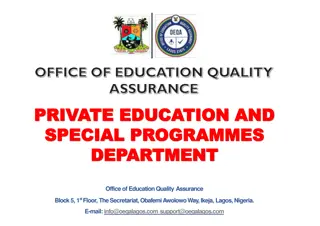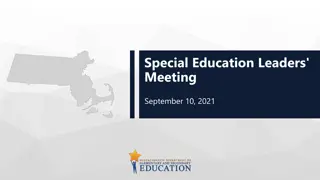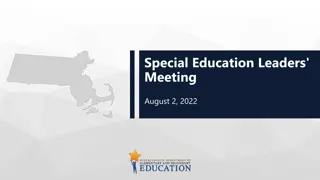Understanding Special Education Programs and Services
Explore the least restrictive environment (LRE) continuum for students with disabilities, ranging from general education classrooms to specialized programs. Learn about a variety of programs and services tailored to meet individual needs, including resource services, co-teaching, and instructional special education classes. Gain insights into how the educational placement is determined based on students' IEPs and eligibility. Dive into the world of special education with a focus on providing a supportive and inclusive learning environment for all students.
Download Presentation

Please find below an Image/Link to download the presentation.
The content on the website is provided AS IS for your information and personal use only. It may not be sold, licensed, or shared on other websites without obtaining consent from the author. Download presentation by click this link. If you encounter any issues during the download, it is possible that the publisher has removed the file from their server.
E N D
Presentation Transcript
Special Education Programs
Least Restrictive Environment (LRE) Continuum To the maximum extent appropriate, students with disabilities, aged 3 through 21, in public or private schools or other facilities, are educated with children who are not disabled. Home/ Hospital Students may move up or down the continuum, based on their individual needs. Residential Private Day School Separate Special Education School in District The student's Individual Educational Program ( IEP ) team, including the student s parent/guardian, determines the educational placement. Inside general education classroom less than 40% of the day - Specialized Program in District Inside general education classroom less than 40% of the day at home school. General education classroom for 40%-79% of the day General Education Classroom for 80% or more of the day with supplementary services and/or resource services General Education Classroom with No Supplementary Aids or Services
Programs and Services The district offers a wide range of special education programming to meet student s individual needs. The type of program and services is recommended based on the student s eligibility and needs as writing in their IEP. Programs and services offered include: Assistive Technology Audiology Hearing Itinerant services Interpreting Services Occupational Therapy Orientation and Mobility Physical Therapy Psychological Services School Health Services Social Work Speech/Language Vision Itinerant services Resource or Co-Taught classes Instructional Special Education Classes Specialized Programs
Resource Services Resource is a separate setting, either a classroom or a smaller designated room, where special education services can be delivered to a student with a disability, individually or in a small group. Resource rooms are used in a variety of ways ranging from instruction, homework assistance, meetings, or representing students' alternative learning space. Support can be academic, social emotional, behavioral, organization, etc.
Co-Teaching Co-teaching is a collaborative approach to instruction in which two teachers, typically a general education teacher and a special education teacher, work together to plan and then implement instruction for a class that includes students with disabilities. This can benefit not only the students with disabilities, but all students who are having difficulty with or are misunderstanding an assignment. Currently available at Middle School and High School. Source: A Teacher s Guide to Special Education, Bateman & Cline
Special Education Instructional Classes (Grades PreK-12) Instructional special education classrooms are designed to allow a more intensive level of special education instruction by subject. Instructional classes may provide support in academics, social emotional, behavioral, organization, etc. Students may be enrolled in one or more instructional classes based on their individual needs.
Specialized Programs Students may be enrolled in all academic classes in a specialized program or in specific classes based on the student s needs. ED Programs BASES RISE Plainfield Academy TAP Multi-needs Programs FBI Intensive STAR Plus P-Step Turnabout Outside of District Therapeutic Day/Private Day Schools Residential Facilities Project Class LEAP
FBI: Functionally Based Instruction SCORE: Secondary, Community, Occupational, and Real-world Experiences (Grades K-12) The Programs: Provide both academic and functional instruction to students with a wide range of disabilities such as; cognitive impairment, autism, health impairment, and multiple disabilities. Have an alternative academic curriculum aligned with Dynamic Learning Maps Use assessment to monitor student progress and inform instructional decisions. Provide students with opportunities for inclusion with general education peers as deemed appropriate by their IEP team. Have a higher staff to student ratio and provides a blend of individual, small group, and whole class instruction Elementary and middle school programs have a base student-to-staff ratio of 3:1. High school programs have a base student-to-staff ratio of 4:1. The number in the chart below indicates the number of classes in the school. Middle School Elementary High School Eagle Pointe (1) Drauden Point Middle School- (2) Plainfield East High School SCORE (4) Eichelberger (2) Heritage Grove Middle School (1) Plainfield South High School SCORE (4) Charles Reed (2) Ira Jones Middle School (1) River View (2) John F. Kennedy Middle School (1) Wesmere (2)
Multi-Needs Intensive (Grades K-12) The program: Provides both academic and functional instruction to students with a wide range of disabilities such as; cognitive impairment, autism, health impairment, and multiple disabilities. Has an alternative academic curriculum aligned with Dynamic Learning Maps. Curriculum resources currently utilized in the FBI program will also be used within the Multi-Needs Intensive classes. Utilize principles of Applied Behavior Analysis (ABA) and Verbal Behavior (VB) within the framework of a functional curriculum. Focuses on the development of positive learner behaviors to support acquisition of skills across various areas Assessments include the Verbal Behavior Milestones Assessment and Placement Program (VB-MAPP) and The Inventory of Good Learner Repertoires. Provides a highly structured environment with a low student to staff ratio. Includes a classroom teacher, teaching assistants, and additional support/consultation provided by a Board-Certified Behavior Analyst (BCBA), Speech Language Pathologist, and Occupational Therapist. Has a higher staff to student ratio and provides a blend of individual and small group instruction. At minimum, there is a 2:1 student to staff ratio. The number in the chart below indicates the number of classes in the school. Elementary Middle School High School Central Elementary (2) Drauden Point Middle School- (1) Plainfield North High School (1) Eagle Pointe (2) Heritage Grove Middle School (1) Lakewood Falls (2) Meadowview (1) Thomas Jefferson (2)
Early Childhood Blended Program Students ages 3-5 with special needs. Students are provided majority of their special education supports and services in a regular early childhood program. The teacher is dually certified in early childhood and early childhood special education. Bonnie McBeth Learning Center Logo Bonnie McBeth Learning Center Logo
STAR Plus (Grades PreK-21) The Program: Provides both individualized instruction to students with a wide range of disabilities such as cognitive impairment, autism, health impairment, and multiple disabilities. The student s individual needs may be severe and profound. Alternative curriculum aligned with student IEP goals and DLM The Verbal Behavior Milestones Assessment and Placement Program (VB-MAPP) is used to monitor student progress and inform instructional decisions. Has a higher staff to student ratio and provides a blend of individual, small group, and whole class instruction Community-based instruction as appropriate. Students are provided opportunities for inclusion with general education peers as deemed appropriate by their IEP team. Instruction is primarily individual or 2:1 student to staff ratio The number in the chart below indicates the number of classes in the school. PreK and Elementary Middle and High School Bonnie McBeth Learning Center (3) Plainfield North High School (2) Wallin Oaks (1)
Plainfield Academy Logo Plainfield Academy logo PSTEP: Post Secondary Education Program The Program: Focused on providing transition from high school to adult life Promotes development of skills necessary to become productive, contributing members of society Provides students with instruction in the skills needed to obtain and maintain employment and increase independent living skills Promotes development of leisure and social skills. Individualizes skill development to meet the students Individualized Education Plan (IEP). Community-based program Development of vocational skills in settings determined by the student s needs (Workshop, BMLC, Project SEARCH at Adventist Medical Center in Bolingbrook, Work Training Partnership @ JJC, Wilco Career Development Center, Community Employment) P-STEP assessment is used to monitor student progress and inform instructional decisions Students may be recommended for the program if the IEP team determines that they need the following educational supports: If they are between the ages of 18-21 and met graduation requirements Require direct instruction in their transition plan in order to meet post-secondary transition goals Locations: Plainfield Academy (3), JJC (3), Bolingbrook Hospital (1)
Project LEAP: Language Enriched Academic Program (Preschool) The Program: 5 hour a day instructional special education program Utilizes research based instructional methodologies in order to support students learning. Principles of Applied Behavior Analysis (ABA) and Verbal Behavior (VB) will be utilized within the framework of the curriculum. Provides small group and individualized instruction Focuses on the child s development in all areas consistent with the preschool curriculum; cognitive, pre-academic, social-emotional, language, motor skills, and self-help. The primary focus is to teach children good learner skills in order to help them be successful in school Individualized to meet students unique learning needs based on their IEP goals and assessments Assessments include Verbal Behavior Milestones Assessment and Placement Program (VB-MAPP), or The Inventory of Good Learner Repertoires. Has a higher staff to student ratio and provides a blend of individual, small group, and whole class instruction Students may be recommended for the program if the IEP team determines that they need the following educational supports: Direct instruction in many of the following areas: cognitive, pre-academic, social-emotional, language, motor skills, and self-help. Skills taught across multiple settings, contexts and staff to facilitate generalization of skills. Small group or individual instruction for majority of the day Instructional methodologies aligned with ABA and VB Direct instruction in foundational good learner skills Locations Bonnie McBeth Learning Center (4), Freedom (2), Liberty (1), Meadow View (1), Wallin Oaks (1)
Project CLASS - (Grades K-3) The Program: Provides both academic and functional instruction to students with Autism Spectrum Disorders (ASD) Curriculum is aligned to District Differentiated Curriculum Provides a highly structured environment that incorporates many visual supports, discrete trial/verbal behavior teaching and behavioral programming, with a focus on communication, language and social skills development. A dual placement format provides for peer interaction and provides opportunities to generalize social and communication skills to the natural environment. Designed to provide support and instruction through 3rdgrade. Students may be recommended for the program if the IEP team determines that they need the following educational supports: Demonstrate ability to benefit from a cross categorical program with an academic focus or regular education setting. Lack of response to traditional teaching methods. Demonstrate need for a highly structured environment. Demonstrate need for discrete trial/verbal behavior instruction and use of visual supports. Location: Lincoln Elementary (3)
ED Program Description (Grades K-12) The Programs - BASES: Building Academic and Social Emotional Skills, RISE: Reaching Individual Strengths and Expectations Our mission is to develop student independence and success through high individual expectations. Traditional instruction and discipline has not worked for many students. In our ED programs, discipline equals learning, not just a consequence as you may find in some traditional learning environments. This instruction is embedded into all areas of curriculum. Specialized instruction in both academic and social skills Preventive Teaching is anticipating the behaviors or social skills necessary for a particular situation and learning, practicing, and reviewing them in advance. Individual Instruction briefly teaches or reviews a social skill or expectation at a neutral time with an individual student or group of students. Corrective Teaching interrupts behavior needing improvement so that a more appropriate response (social skill) can be taught, reviewed, practiced and then reinforced. Corrective teaching allows educators to blend teaching social skills with ongoing classroom management. 16 Essential Social Skills are taught through the use of a progress card. This tracks goals identified by the IEP team. Highly structured, behaviorally focused learning environments. Students receive direct social work services through individual and group counseling weekly. Students are seen on a crisis basis at any time. Ongoing de-escalation techniques used in the Corrective Teaching Process include: Verbal Praise, Rationales, Empathy, Specific Instructions, Coupling Statements, Quiet and Soft Communication. Has a higher staff to student ratio and provides a blend of individual and small group instruction. This is supported by a higher allocation of social work which also supports the discipline progress. Students follow the district curriculum and students take common district and state assessments, as appropriate.
ED Program: Placement Considerations Locations: Elementary Middle School High School BASES Creekside (2) BASES Ridge (2) RISE Ira Jones Middle School (2) RISE Plainfield Central High School (4) In most cases, after intensive intervention occurred including preventative and positive interventions and were unsuccessful, FBA/BIP interventions have been exhausted, and there has been consultation with district behavioral specialists, students may be recommended for the program if the IEP team determines that they need the following educational supports: Direct instruction in both academic and social emotional/behavioral skills Intensive, frequent social work support A highly structured behavior focused environment Direct instruction in generalization of social emotional/behavioral skills across a wide variety of settings Frequent de-escalation or reinforcement in appropriate behaviors Students must have an FBA and BIP Significant intervention-In building support with FBA/BIP, smaller class sizes, social work support, etc.
Plainfield Academy Logo Plainfield Academy logo Grades 6-12 All other ED programs can attend classes including specials, lunch, and passing periods in the larger school environment. For some students, these less structured environments can cause stress resulting in maladaptive behaviors. For students who required a greater degree of structure, or who are Board placed out of their home school, Plainfield Academy provides the same benefits of the traditional ED programming with the structured environment that the traditional school lacks. Programming Includes: Restitution/Late Bus Shorter School Day More structure in the halls, lunch, etc. More immediate social work support No changing for PE Teaching of 16 essential social skills Extracurricular activities within the school day (CAAEL) Teaching of core curriculum paralleled to general education environment Participate in activities at his home school Small group setting Discipline is a therapeutic learning experience, not always a consequence Teachers are trained in behavioral supports/relationship building Avoid building negative reputation 8 Period day Access to Wilco Safety supervision Service dog-Leroy
Outside of the District Therapeutic Day/ Private Day Schools Nonpublic private facility - ISBE Approved Schools These placements are considered when the IEP team has determined that the public school district can no longer offer services that match the student's needs, either educational or emotionally. A special education private facility can offer unique supports and services that are may not be offered in the public school such as intensive behavioral supports, therapeutic settings, and smaller class sizes. There are different types of private schools that focus on different disability areas. The student s home district remains responsible for writing the student s IEP and ensuring the student reaches his or her IEP goals. The home district and nonpublic program together are responsible for making sure the student s special education needs are being met. These facilities also provide opportunities for social and emotional growth and a parallel curriculum so students can be reintegrated back into their home school districts
TAP: Therapeutic Academic Program (Grades 6-12) The mission of the Therapeutic Academic Program is to help students who are struggling with emotional and social challenges to achieve their potential academically and adaptively so they may become healthy, responsible and productive adults. Students work within a more systemic behavior program that teaches coping strategies and allows for frequent breaks and processing with clinical staff. Students receive direct social work services through individual and group counseling weekly. Students are seen on a crisis basis at any time. Students may be recommended for the program if the educational team determines that they need the following educational supports: A therapeutic environment Frequent, daily access to social work support Direct instruction in both academic and social emotional/behavioral skills Direct instruction in coping skills Small group instruction throughout the day Location: Plainfield Academy (4)


